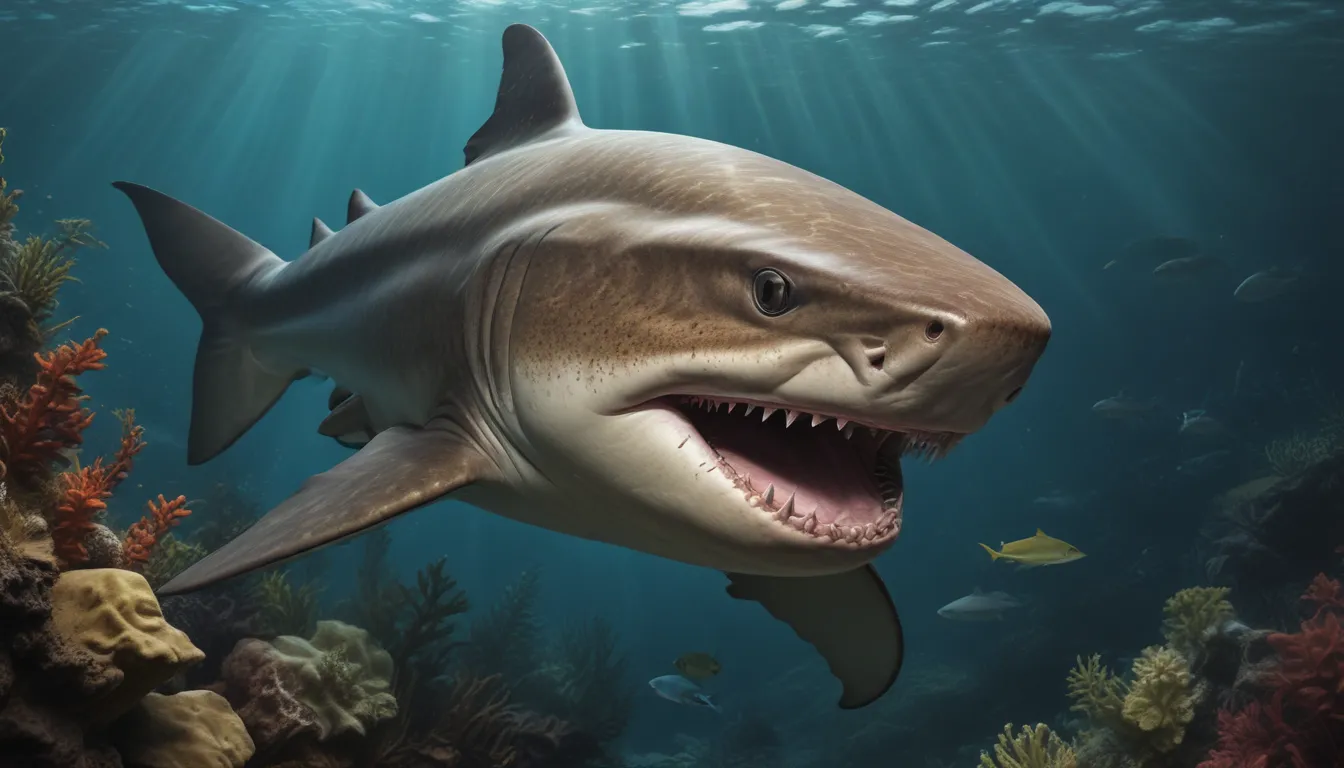The pictures we use in our articles might not show exactly what the words say. We choose these pictures to make you interested in reading more. The pictures work together with the words but don’t take their place. The words still tell you the important facts.
The nurse shark, scientifically known as Ginglymostoma cirratum, is a captivating species that calls the warm coastal waters of the Atlantic and eastern Pacific oceans its home. Despite its misleading name, this gentle giant is not a healthcare provider but rather a docile creature known for its sluggish behavior, reminiscent of a nurse attending to patients.
Join us as we delve into 12 fascinating facts about nurse sharks that will expand your knowledge and appreciation for these incredible beings. From their physical attributes and dietary preferences to their reproductive behaviors and conservation status, nurse sharks boast a myriad of captivating characteristics waiting to be discovered. Let's embark on a journey to uncover the extraordinary world of nurse sharks and gain a newfound admiration for these remarkable creatures.
Understanding Nurse Sharks: A Closer Look
- Nurse sharks are gentle giants that play a crucial role in coral reef ecosystems. They are nocturnal, have a diverse diet, and are revered for their non-aggressive nature, making them a popular sight for divers.
- Despite facing environmental threats, nurse sharks are adaptable survivors with a long lifespan. They hold cultural significance in some regions and are currently listed as a species of least concern, emphasizing the importance of conservation efforts for their future well-being.
Habitat and Range
Nurse sharks, scientifically known as Ginglymostoma cirratum, are commonly found in the warm coastal waters of the Atlantic and Pacific Oceans. They inhabit shallow waters of coral reefs, sandy flats, and rocky areas, making them a common sight for divers and snorkelers.
Size and Appearance
The nurse shark is a sizable species that can reach lengths of up to 14 feet. With a stout body, broad head, and distinctive barbels around their mouth resembling a catfish, nurse sharks exhibit a unique physical appearance. Their skin, usually gray or brown, is covered in small denticles that impart a sandpaper-like texture when touched.
Diet and Feeding Habits
Nurse sharks are opportunistic feeders with a diverse diet comprising bottom-dwelling creatures such as crustaceans, mollusks, and small fish. Their feeding habits are characterized by a suction method, allowing them to capture prey by sucking it into their mouths with remarkable force.
Nocturnal Behavior
Primarily nocturnal, nurse sharks are most active during the night. During the day, they tend to rest in groups on the ocean floor, seeking refuge in caves or under ledges. Under the cloak of darkness, they emerge to forage for food, relying on their acute sense of smell to locate their prey.
Non-Aggressive Nature
Contrary to misconceptions, nurse sharks are generally non-aggressive and pose limited threats to humans. Their docile nature often sees them peacefully resting on the ocean floor, enabling divers to approach them closely. However, respecting their space and maintaining a safe distance is imperative when interacting with these wild animals.
Reproduction and Mating
Nurse sharks engage in internal fertilization, with males utilizing specialized organs called claspers near their pelvic fins to transfer sperm to females. Following a gestation period of approximately six months, females give birth to live young, typically yielding litters of 20-30 pups.
Long Lifespan
Compared to other shark species, nurse sharks boast a relatively long lifespan. With individuals capable of living up to 25-30 years, some reports even suggest that they may endure up to 40 years under optimal conditions. Their sluggish growth rate and low reproductive output contribute to their extended longevity.
Importance in Coral Reef Ecosystems
Nurse sharks assume a critical role in maintaining the equilibrium of coral reef ecosystems. As opportunistic feeders, they aid in regulating the populations of various prey species, preventing overpopulation and fostering the overall health of coral reefs.
Environmental Threats
Similar to numerous marine species, nurse sharks confront myriad threats stemming from human activities. Overfishing and habitat destruction loom as primary concerns jeopardizing their survival. Conservation initiatives and marine protected areas play a pivotal role in safeguarding these magnificent creatures and their habitats.
Cultural Significance
In certain cultures, nurse sharks hold profound symbolism. For instance, in the Bahamas, they are revered as guardian spirits associated with protection and good fortune. Serving as a popular tourist attraction, nurse sharks allure divers from across the globe keen on witnessing their splendor.
Conservation Status
Currently categorized as a species of least concern by the International Union for Conservation of Nature (IUCN), nurse sharks underscore the need for ongoing monitoring and conservation endeavors to avert potential population declines in the future.
Adaptable Survivors
Evolved as highly adaptable survivors, nurse sharks exhibit resilience in diverse habitats and environmental conditions. Their capacity to endure low oxygen levels and thrive in captivity renders them invaluable subjects for scientific research, shedding light on their remarkable adaptability.
Dive Deeper into the World of Nurse Sharks
In a nutshell, nurse sharks enthrall enthusiasts worldwide with their captivating traits. Ranging from their distinct appearance and behavior to their pivotal role in marine ecosystems, nurse sharks stand as awe-inspiring creatures deserving of admiration and preservation. Whether exploring tropical waters alongside these gentle giants or unraveling their intricacies from afar, these 12 facts provide a glimpse into the enthralling realm of nurse sharks, underscoring their significance in our oceans and warranting our utmost respect and protection.
Frequently Asked Questions
- Are nurse sharks dangerous?
-
Nurse sharks are generally not considered dangerous to humans, exhibiting a docile and non-aggressive demeanor unless provoked.
-
What do nurse sharks eat?
-
Nurse sharks are opportunistic feeders, dining on a variety of prey including small fish, stingrays, crustaceans, and invertebrates.
-
How big do nurse sharks get?
-
Nurse sharks can reach lengths of up to 14 feet, with most individuals falling within the 7 to 9-foot range, typically with females being larger than males.
-
Where can nurse sharks be found?
-
Nurse sharks are commonly spotted in warm tropical and subtropical waters, encompassing the western Atlantic Ocean, the Caribbean Sea, and segments of the eastern Pacific Ocean.
-
Are nurse sharks endangered?
-
Nurse sharks currently hold a status of least concern on the IUCN Red List; however, threats from habitat destruction, overfishing, and bycatch present potential risks to their populations.
-
How long do nurse sharks live?
-
Nurse sharks boast a relatively extended lifespan, living up to 25 years in the wild and potentially exceeding 30 years in captivity.
-
Do nurse sharks have predators?
-
Nurse sharks face limited natural predators, with larger sharks like tiger sharks and bull sharks occasionally preying on them. Human activities, including overfishing and habitat degradation, also pose threats.
-
Are nurse sharks social animals?
-
While predominantly solitary, nurse sharks may gather in small groups during specific periods such as mating or when food sources are abundant.
-
How do nurse sharks reproduce?
-
Nurse sharks are ovoviviparous, giving birth to live young with females nurturing the eggs internally until the pups are fully developed during birth.
-
Are nurse sharks nocturnal?
- Nurse sharks exhibit nocturnal tendencies but may also be active during daylight hours. They typically seek refuge in caves or under ledges during the day and engage in feeding activities at night.
-
Can nurse sharks be kept as pets?
- Nurse sharks are unsuitable pets for the average aquarium enthusiast, requiring specialized large tanks, pristine water conditions, and a varied diet that poses challenges in captivity.
-
Can I swim with nurse sharks?
- Absolutely! Popular among snorkelers and scuba divers, nurse sharks offer a thrilling opportunity to interact with these gentle creatures in their natural habitat, providing a memorable and enriching experience.
Embark on an enlightening journey into the enigmatic world of nurse sharks, where their captivating traits and ecological significance unfold with every discovery. For further exploration of intriguing shark species, venture into the realm of milk sharks, unveiling a treasure trove of distinctive behaviors and characteristics awaiting your curiosity.
Our dedication to delivering authentic and engaging content is the cornerstone of our mission. Each fact presented on our platform is contributed by real users like you, offering a diverse range of insights and knowledge. With meticulous scrutiny from our committed editors, every submission undergoes rigorous review to uphold the highest standards of accuracy and reliability. Trust in our commitment to authenticity as you immerse yourself in the world of education and exploration with us.






